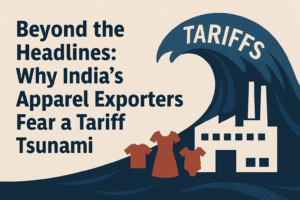Beyond the Headlines: Why India’s Apparel Exporters Fear a Tariff Tsunami
India’s apparel exporters face a severe crisis as new US tariffs disproportionately target them at 25%—significantly higher than key competitors like Bangladesh (20%) and Vietnam (20%). This threatens India’s hard-won US market share, which grew from 4.5% to 5.8% (2020-2024) and drives 33% of the sector’s exports. Industry leaders warn factories must now sell below cost to survive, risking mass layoffs.
The tariff disparity compounds existing challenges, undermining decades of progress just as China’s dominance wanes. Exporters urgently seek government intervention through cost relief and trade diplomacy, while broader India-US negotiations remain stalled over agriculture disputes. Without swift action, this selective penalty could reverse critical economic gains and devastate livelihoods.

Beyond the Headlines: Why India’s Apparel Exporters Fear a Tariff Tsunami
While India’s textile industry has been steadily gaining ground in the crucial US market, a sudden policy shift from Washington has thrown exporters into crisis mode. The recent announcement of 25% US tariffs specifically targeting Indian apparel imports – significantly higher than rates imposed on competitors like Bangladesh (20%), Vietnam (20%), and Cambodia (19%) – is more than a trade barrier; it threatens livelihoods, factories, and hard-won market share.
The Sting of Selective Tariffs:
The core issue isn’t just the tariff hike itself, but its discriminatory nature. As Sudhir Sekhri, Chairman of the Apparel Export Promotion Council (AEPC), starkly warned, exporters now face an impossible choice: “sell below cost to keep factories running and avoid mass layoffs” or lose their foothold in a market accounting for 33% of India’s total garment exports. This 5%+ disadvantage against key rivals like Bangladesh and Vietnam is unsustainable in a fiercely competitive, low-margin industry.
A Paradox of Success Under Pressure:
This blow lands just as India’s apparel sector was demonstrating resilience. Despite global headwinds:
- India’s share of the US garment import market climbed from 4.5% (2020) to 5.8% (2024), securing its position as the 4th largest supplier.
- Key product categories like cotton T-shirts, women’s cotton dresses, and cotton baby garments held significant global market shares within the US (10%, 36%, and 20% respectively).
- India was naturally benefiting from China’s declining US market share (down from 27.4% to 21.9% over the same period).
The new tariffs risk halting – or even reversing – this positive trajectory. Rakesh Mehra, Chairman of the Confederation of Indian Textile Industry (CITI), highlighted the immediate threat: “We will be handicapped by a severe duty disadvantage… compounding the difficulties” exporters already face.
The Human and Industrial Cost:
Beyond the statistics lie pressing human and economic concerns:
- Job Losses: Mass layoffs are a real fear as factories struggle to absorb the tariff cost without pricing themselves out of the market.
- Investment Chill: Uncertainty deters investment in modernization and expansion needed to compete globally.
- Raw Material Strains: CITI simultaneously calls for easier raw material access, indicating broader systemic pressures beyond just the US tariffs.
Seeking Solutions Beyond Quick Fixes:
Exporters urgently seek government intervention. While direct subsidies are complex under trade rules, potential avenues include:
- Enhanced Export Incentives: Revisiting schemes like RoDTEP (Remission of Duties and Taxes on Exported Products) to improve rebates.
- Cost Reduction: Addressing domestic issues like high logistics costs, power tariffs, and complex compliance to improve overall competitiveness.
- Diversification Push: Accelerated support for exploring non-US markets to reduce overdependence.
The Broader Trade Impasse:
This tariff crisis unfolds against the backdrop of stalled India-US trade negotiations. Sticking points, particularly US demands for access to India’s agricultural market for genetically modified products and India’s protection of its farm sector and auto industry, remain significant hurdles. A broader trade deal could potentially resolve the tariff disparity, but the deep divides, especially on agriculture, offer little immediate hope.
The Road Ahead:
India’s apparel exporters face a critical juncture. The selective 25% US tariff is not merely a policy change; it’s an existential threat to their largest market. While government support is crucial for immediate survival, long-term resilience requires:
- Aggressive Cost Optimization: Streamlining domestic production and logistics.
- Market Diversification: Reducing reliance on the US.
- Value Chain Integration: Leveraging initiatives like the PM-MITRA parks to create efficient, integrated hubs.
- Diplomatic Push: Renewed, pragmatic efforts to resolve the underlying trade tensions with the US.
The coming months will test whether India’s hard-earned gains in the global apparel trade can withstand this targeted tariff storm, or if the industry will be forced into painful contraction just as its potential seemed brightest. The need for decisive action – both from exporters and policymakers – has never been more urgent.
You must be logged in to post a comment.